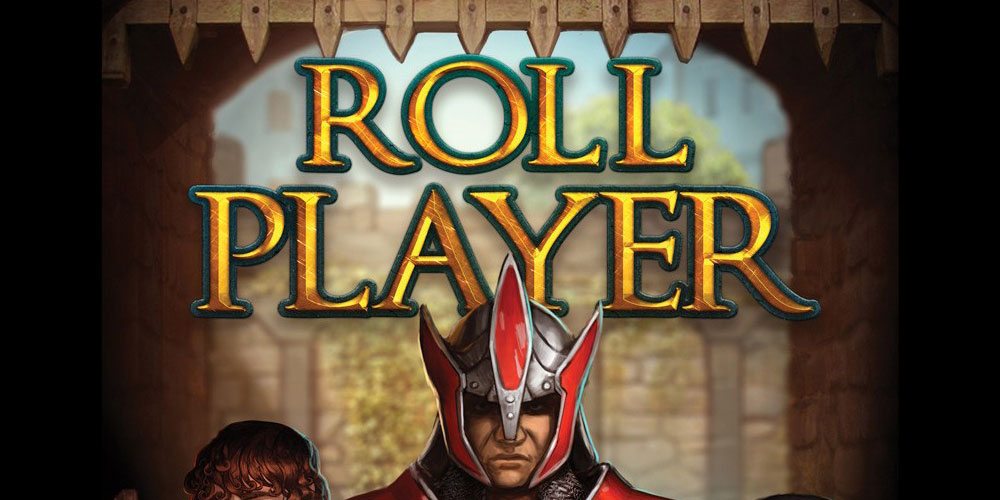“Reaping the Rewards” is a series looking at the finished product of a crowdfunding campaign. Today’s title: Roll Player, which was funded on Kickstarter in December 2015 and shipped to backers in the fall of 2016. It’s a game about building a character for a role-playing game by drafting dice and acquiring gear, traits, and skills. This post is taken from my original prototype review, revised to reflect the final published version.
At a glance: Roll Player is for 1 to 4 players, ages 10 and up, and takes 60-90 minutes to play. It retails for $60, and is available directly from Thunderworks Games, from Amazon, or at your local game store. The game uses a lot of typical material for role-playing games, so there isn’t much that would be inappropriate for younger players, but there is a lot to keep track of. It’s not overly complex, but can look intimidating at first.

Components:
- 6 Character boards
- 6 Class cards
- 16 Backstory cards
- 17 Alignment cards
- 53 Market cards (Skills, Weapons, Armor, and Traits)
- 5 Initiative cards
- 4 Player Aid cards
- 12 tracking tokens (2 per class color)
- 6 Charisma tokens
- 60 Gold tokens
- 1 drawstring bag
- 73 six-sided dice (10 each in Green, Blue, Red, Purple, Black, White; 13 Gold)

The Character boards are where the action takes place. Each board has a different race (Human, Elf, Dwarf, Halfling) and there is room for the Class, Backstory, and Alignment cards. Market cards (Skills, Weapons, Armor, and Traits) go around the board in areas marked near the edges. In the center of each board is a large section with 18 holes for the placement of dice. The Character boards are double-sided, so there is a male and female version of each one–no difference in gameplay, but it allows each player a choice of which side to use. That’s a nice touch.
Everything looks pretty great. The artwork and design is by the same folks who worked on Bullfrogs, the first Thunderworks Games title: John Ariosa and Luis Francisco. For the most part, all the icons and symbols are fairly intuitive, once you’ve read through the rulebook once.

The Class cards are double-sided, making a total of 12 possible Classes to choose from, with each card having related classes on either side, like Barbarian or Warrior. The cards all have a linen finish, and are sturdy cards with a nice snap to them; I’m seeing a little wear on the edges of the cards after several plays, but for the most part they’re fine.
The dice are standard-sized dice, and there are a whole bunch of them. The gold tokens are cardboard punchouts, and the tracking tokens are small wooden cubes. The drawstring bag is quite nice, and plenty big to hold all of the dice.
Overall, it’s a nice-looking game, and the board is particularly nice.
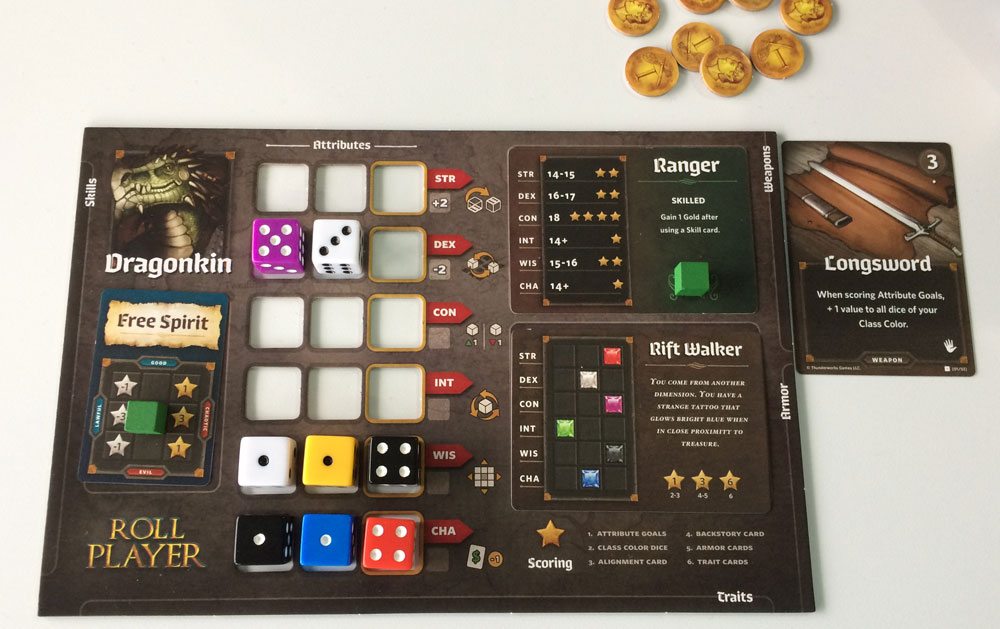
How to Play
You can download a copy of the rules here.
The goal of the game is to build the character with the highest reputation by the time all the Character sheets are filled in. (The solitaire version is similar but you are trying to achieve a particular score to win.)
Each player gets a Character board–this has the player’s race on it. The boards are nearly identical, but each race has its own strength and weakness. The Human is average all around, but each of the other races has a +2 on one stat and a -2 on another. For instance, the Elf has +2 Dexterity and -2 Constitution.
Then, each player gets one of the Class cards–you can randomize these, or let everyone choose. Each Class has an associated color (indicated by the little square at the bottom right), and various goals for the attributes. Each Class also has a special ability that will apply during the game.
The Class cards are double-sided, so you get to choose which side you’d like to use. The two sides are related: Cleric/Paladin, Sorceror/Wizard, and so on. They have different attribute goals and different special abilities. Choose which one you’d like to use, and place it on your board.
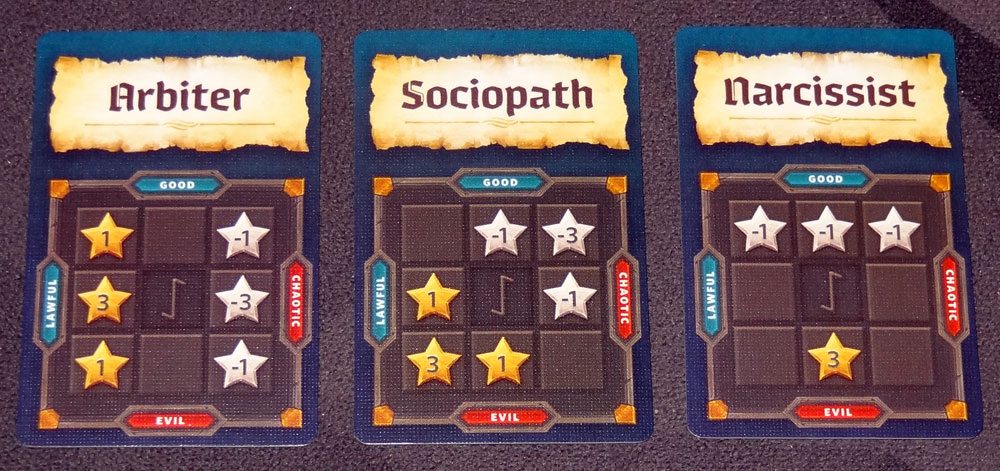
You also get an Alignment card–it has some combination of points and penalties for reaching a particular alignment at the end of the game. For instance, the Hermit gets 3 bonus points for being Neutral Neutral. The Truth Seeker gets the most points by being Lawful Good, and loses the most points for being Chaotic Evil. You place one of your tracker cubes in the center square at the beginning of the game, and the card is placed on the board below the portrait.
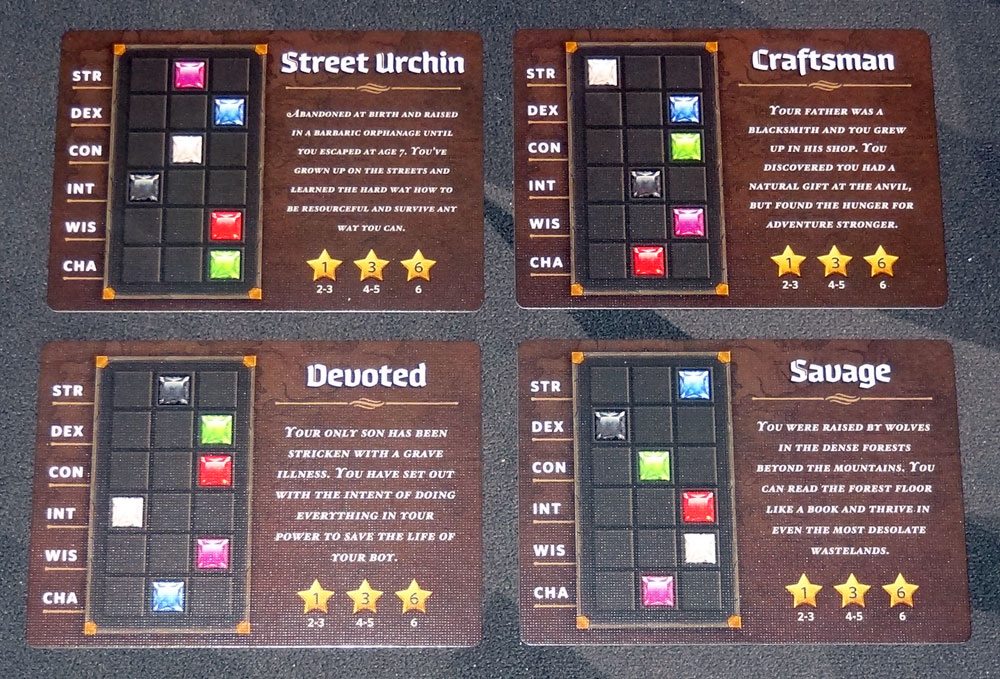
Each player also gets a Backstory card–it has a title and little story, which is just for flavor. On the left there’s also a little chart showing one color in each attribute row. If you manage to get matching dice in those positions by the end of the game, you’ll get bonus points. This choice is less strategic, because there’s just one die in each class color represented no matter which card you take.
Set up the Market deck. Take all of the cards with two dots below the price and shuffle those, and then all the cards with one dot and shuffle them separately. Depending on the number of players, you’ll also remove a set number of Market cards at random. Combine them into one deck with the one-dot cards on top. Draw 1 more Market cards than there are players, and place them in the center of the table. Set out the same number of Initiative cards. The Initiative cards that are not first or last get 1 gold put on them. The Initiative cards are marked with the number of players, and some of them have gold coin icons on them to remind you to place coins on them.
Everyone gets some gold to start (depending on number of players), and also draws a number of dice out of the bag. These dice are all rolled and placed into the character board, filling rows from left to right. You collect 2 gold for each gold die you get, and you also get 1 gold for each attribute row that you fill. However, you do not take any attribute actions for these starting dice. You get to decide where to place these starting dice.
Now the game is ready to begin!
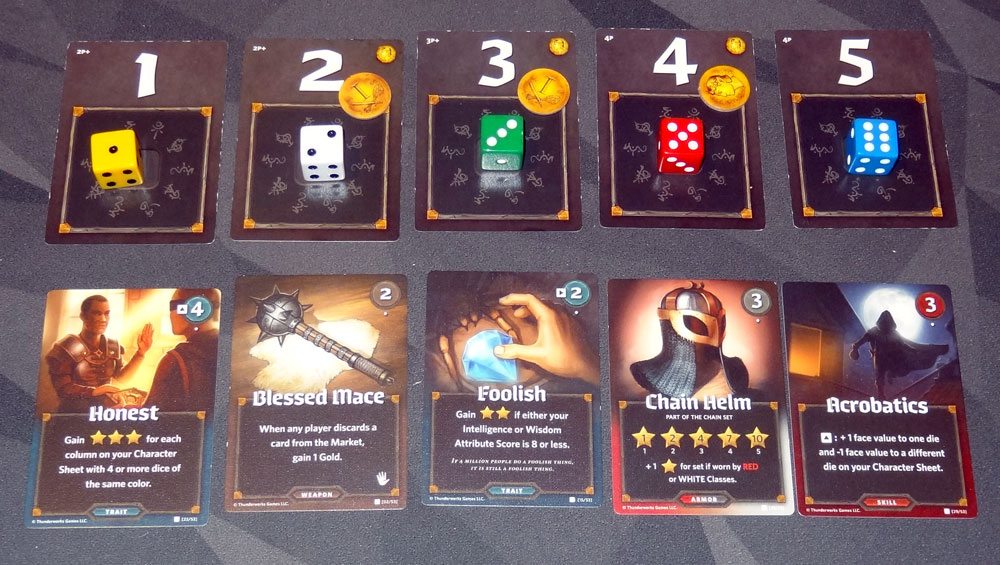
On each round, the starting player first draws dice out of the bag, rolls them, and places them in ascending order on the Initiative cards. (In case of ties, the starting player chooses the order.) Then, in clockwise order, each player will take one of the Initiative cards, along with the die and gold, if any, that is on the card.
The die is placed on the character board in an attribute space, and then the player may take the associated attribute action (affecting your own character):
- Strength: Flip any die on your board to its opposite face.
- Dexterity: Swap the locations of any two of your dice.
- Constitution: Increase or decrease a die on your board by 1.
- Intelligence: Re-roll a die on your board; keep the new roll or the original value and put it back in the same spot.
- Wisdom: Move your Alignment tracker 1 space in any orthogonal direction.
- Charisma: Receive a Charisma token, worth $1 discount at the Market this round.
Any time you take a gold die, you get 2 gold. Whenever you fill the last space in a row, you get 1 gold.
After everyone has picked an Initiative card, everyone gets to go to the Market in Initiative order. Either buy a card by paying gold to the bank, or discard one of the cards and take 2 gold from the bank.
Here are the four types of Market cards:

Weapons have various types of effects. You can only have up to 2 hands’ worth of weapons, and must discard a weapon if you exceed that.

Armor cards award points based on the number of cards you collect from that set. In addition, each type of armor also awards a bonus point to particular Classes.
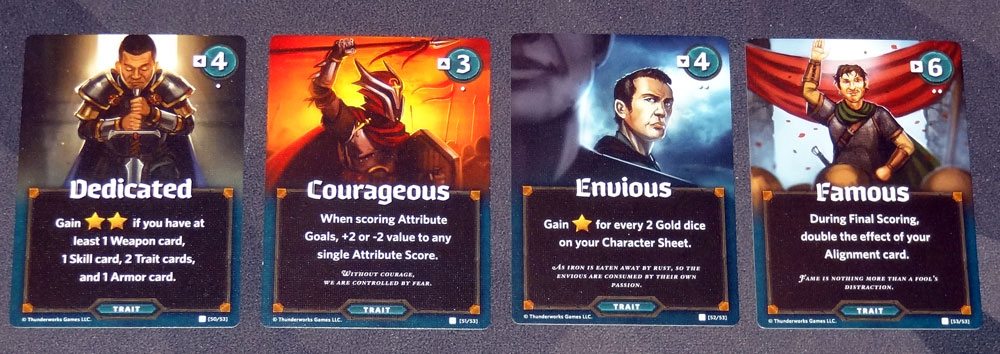
Trait cards generally award points for meeting particular conditions, or they may help you achieve specific goals. Also, when you purchase a Trait card, you immediately adjust your Alignment according to the little arrow next to the price. If your Alignment cannot move any further in that direction, it just stays put.

Skills can be used at any time after you purchase them, even on the same round if applicable. To use a Skill, you must be able to move your Alignment one space in the direction indicated, and then that Skill is exhausted. Note: you may exhaust a Skill card by moving your Alignment and declining the effect of the skill.
Finally, once everyone has been to Market, the remaining Market card is discarded, the remaining die is returned to the bag, and all the Initiative cards are returned to the center. A new set of Market cards are set out, gold is refilled on the Initiative cards, and the starting player passes to the next player and a new round begins. Each player may now refresh one Skill.
The game ends after the round in which the boards are filled.
Scores are calculated as follows:
- Attribute goals: You score points if your attribute values match the goals on your Class card. If it shows an exact number, you must hit that number exactly. Don’t forget the bonuses and penalties for your Class.
- Class dice: You get 1 bonus point for each die of your Class color.
- Alignment: Add or subtract points based on your position on your Alignment card.
- Backstory: Score points based on the number of dice that match your Backstory card.
- Armor: Score based on your Armor collections, plus bonus points if it matches your Class color.
- Traits: Add points based on your Traits.
The highest score wins! Ties go to most gold, and then fewest Class dice.
Variants
There are a few variant rules available. For instance, if you want the initial setup to be less random, you can distribute dice so that everyone has the same set of starting dice (though you still roll them before placing). You can also shuffle the entire Market deck together, rather than separating the one-dot and two-dot cards first. For a shorter game, draw additional dice at the beginning of the game during setup. Finally, the “Friendly Market” variant lets you take 2 gold instead of buying a card from the Market, but you don’t discard cards.
The Solo rules are set up like a 2-player game, but there is an “enemy die” which is used when you are not first in Initiative order. The die is rolled to determine which card in the Market is moved to a trash pile, as if another player purchased it. In the solo game, you check your final score against a table to see how you did.

The Verdict
When I first heard the theme of Roll Player, I was immediately reminded of the conversations some of the GeekDads had just been having about creating characters in videogames–often spending hours just deciding on a character’s name, appearance, and so on. Certainly crafting your perfect character takes some time and consideration and can feel like a game in itself, even before your character takes its first step. So why not turn character creation itself into a full-fledged game?
I really liked Keith Matejka’s previously published game, Bullfrogs, which was a smaller strategy game, and I was very curious to see Roll Player. Roll Player is a fun mix of RPG tropes and a Euro-style game. Plus, hey, I like the pun in the title. (“The Dice Game That Builds Character”—I see what you did there.)
The game looks great—Ariosa’s artwork shines, and fits the fantasy theme. The cut-outs for the dice on the player boards are a nice touch, because you could play this game with just printed squares on a board, but the holes help everything stay in place and are a very nice feature. The components are all nicely done, particularly the boards.
There is some luck involved in the combination of Class, Race, Alignment, and Backstory you get. For instance, if you get the Warrior/Barbarian Class but you’re a Halfling, it’s going to be hard to max out your Strength, and your Charisma bonus is sort of wasted. Still, there are a lot of different ways to get points in this game, including traits that will give you points for having specific low attributes. The trick is finding a strategy that works for your current situation. With so much dice-rolling, you know there’s a high degree of chance in this game, but I like the fact that there are so many ways to manipulate the dice using the attribute skills and the Market cards.
I like that there are choices to be made even during setup. (I suppose you could argue that the entire game is setup, to some extent, but you know what I mean.) The choice of which side of your Class card to use is important, as is the placement of your initial dice. When you roll your starting dice and place them, you have several things to juggle: whether the colors match up with your Backstory card, whether your numbers are high enough to reach your Attribute goals, and which Attribute actions you’re willing to sacrifice as your “dump stats.” If you place three of your initial dice in your Strength row, you’ll start with an extra gold, but you won’t be able to take advantage of the “flip a die over” ability later in the game.
The Initiative/Market phase is clever: in general, most players want higher dice values, but taking the higher dice means you have a later Initiative, and won’t get your first pick of the Market. There’s definitely some strategy there, deciding whether it’s more important to get a higher die, some gold, or first pick in the Market. In our games, there have definitely been times when somebody took a low die simply to prevent another player from getting a Market card they really wanted.
I like the various types of cards and how they’ll drive your future strategy. Traits generally award points for meeting particular qualifications. You might get extra points for having the same value going across a row, or having a bunch of Skills, or getting all seven dice colors. It can also be extremely helpful to get one of the “negative” traits like Weak or Reckless, because they can award you points for your dump stats (Attributes with very low scores). Collecting Armor is a good way to buy points, but it doesn’t give you any additional abilities–and other people can snatch up Armor that you’re collecting, or even just discard it for gold to prevent you from getting it.
The Skills can be a huge benefit, if used properly. Since you can only use them by moving your Alignment, you have to weigh the benefits of using a Skill against moving your Alignment in potentially the wrong direction. Or, you could try to get two Skills that move in opposite directions–but you only get to refresh one per round.
All in all, the combination of different types of Market cards allows for lots of different tactics: build up gold so you can buy a lot of Traits for extra points; get Skills that let you manipulate the dice (while also moving your Alignment around); collect armors for bonus points.
The primary interaction between players is in the choice of Initiative and Market cards, and then mostly in terms of taking something that somebody else wants. You can’t do anything about cards and dice that somebody has already collected. So it can feel that player interaction is slightly limited, but it also feels like that makes sense thematically. You’re all building characters, not playing a role-playing game yet. But there is still a good amount of interaction in your Market choices, and there are cards that allow you to manipulate the dice that haven’t been claimed yet, potentially making the results worse for the players following you.
I’ve played this with some adult gamers and my kids (who are right on the edge of the age recommendation), and most of the players have enjoyed it. It’s not for everyone, but I really enjoyed it myself, and most gamers who have even some passing knowledge of RPGs enjoy the theme. Because of the number of ways to collect points, and the fact that you have to hit some of your attribute goals exactly, it does require a lot of arithmetic while you’re playing. It’s not hard math, but there’s just a lot of it.
Overall, I think Roll Player is a fun game with a really clever theme. The finished game turned out really nicely; there weren’t any significant rule changes, just some additional character boards and cards from stretch goals hit during the campaign, adding even more variety. If you’re the sort of person who has as much fun coming up with a character as you do actually playing a game, I think this one would be right up your alley.
Disclosure: I received a review copy of this game.
